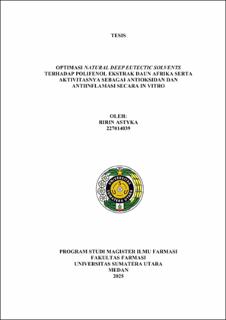| dc.description.abstract | Background: Vernonia amygdalina, or bitter leaf, has long been recognized in traditional medicine for its wide-ranging benefits. This plant contains various polyphenolic compounds that act as antioxidants and anti-inflammatories. In facilitating the enhancement of polyphenol extraction from bitter leaves as candidates for natural antioxidants and anti-inflammatories, extraction optimization becomes an important step. One of the methods that can be used is ultrasonic-assisted extraction (UAE) and the use of the green solvent natural deep eutectic solvent (NADES).
Objective: This research was conducted to optimize the polyphenol content and determine the antioxidant and anti-inflammatory activity of NADES extract from Vernonia amygdalina leaves (NEVA) in vitro. Response Surface Methodology (RSM) is used to determine the optimum conditions for polyphenol extraction.
Method: Characterization of Vernonia amygdalina leaf simplicia using macroscopic tests, determination of water-soluble extractive content, ethanol-soluble extractive content, moisture content, total ash content, and acid-insoluble ash content. Identification of the main phenolic compounds using LC-HRMS, transmission electron microscopy (TEM), and fourier transform infrared (FTIR). The optimization results were confirmed as total phenols. This optimization design used two factors, namely (X1) the ratio of choline chloride & glucose and (X2) the ratio of water. The antioxidant and anti-inflammatory activities of ENDA were evaluated using DPPH testing, inhibition of reactive oxygen species (ROS), nitric oxide (NO), and TNF-α in RAW 264.7 cells induced with lipopolysaccharide (LPS) after selecting concentrations that provided cell viability >80%.
Results: The characterization of the simplicia met the overall requirements, supported by the discovery of phenolic compounds through HPLC analysis, FTIR, and the interaction between NADES and the sample on TEM. The optimized extract showed the highest total phenol content, namely 163.50 mg/GAE mL of sample under conditions (X1:X2) 1:1.413 and 79.125%, with an IC50 value of 1.524% in the antioxidant test. In the anti-inflammatory test, a NEVA concentration of 12.5% was the effective concentration that could reduce ROS, NO, and TNF-α levels the most, namely 2.5% ± 0.00, 8.812 µM ± 0.6 and 70.569 ± 3.04 pg/mL, respectively.
Conclusion: The extraction procedure developed by the RSM design proved to be efficient in enriching the extract with phenolic compounds that possess promising antioxidant and anti-inflammatory activities. | en_US |


